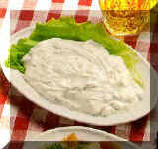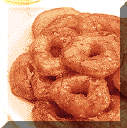CYPRUS
RECIPES
|
|
My Tomato sauce for Pasta
(with
Commanderia)
Slice onions as you like them, fry gently but
well with a pinch of sugar in olive oil.
Add either tomato puree or fresh , skinned tomatoes( for fresh use 2x onions, for puree
use half the amount of the onions.) Fry gently but very well, until
the oil and tomato
merges and is obviously cooked.
Then add a large dash of Commanderia ( usually half a wine glass to 2 medium
sized onions) Then season sparingly with mixed herbs, celery salt and pepper. Add a stock
cube and water. Cook for a further 10 minutes, or all day. Taste and adjust...mmmm

|
HORIATIKI / GREEK SALAD
Ingredients:
Four tomatoes, sliced in segments (must be hard,
salad tomatoes.
One sliced onion
1/2 sliced cucumber
Some olive oil
lemon juice
chopped parsley and /or coriander
Sliced feta cheese (a white, salty cheese made with goats milk)
Salt, pepper. and oregano seasoning
olives
Mix
the ingredients together and spread the oil over them. Sprinkle some salt, pepper and
oregano.


|
MELITZANOSALATA / EGGPLANT SALAD
Ingredients:
Four medium size eggplants/aubergines
Three garlic cloves
1/2 cup of olive oil
Put the
eggplants in the oven, and cook until they feel very soft(about 40 minutes in a normal
oven). Using a sharp knife, slice in half, and using a spoon, remove the inside 'meat' and
place in a bowl. If the eggplants are well done, the inside should come out very easily.
Put the garlic cloves in a garlic press and spread the garlic on top of the eggplant.
Using a fork, start mixing the garlic and the eggplants together, and spread the oil a
little at a time. When the oil is absorbed, the salad is ready. Put in a fridge to cool
and serve with sprinkled parsley. Eggplant salad (also called poor man's caviar) is eaten
with pita bread

|
Skordalia
Thick garlic Sauce
Ingredients;
4 medium slices stale bread, crusts removed,
soaked in water for 10 minutes
4 cloves garlic, peeled and sliced
2 tablespoons wine vinegar
4-5 tablespoons olive oil
salt
1-2 tablespoons water, if necessary
Serves 4
persons!
Squeeze
excess water from the bread, but do not leave it too dry; it should be moist. Put the
bread, garlic and vinegar in the liquidizer and blend well; add the olive oil a little at
a time and blend. Season with salt. If the mixture appears too dry, add the water. The
sauce should be of a runny consistency by the time it is finished. Serve separately in a
bowl, with fried vegetables such as slices of fried aubergines, with fried fish or
sometimes with boiled chicken. Its sharpness varies according to the amount of garlic,
from mild to really hot and burning.

|
Stifado
Beef Casserole with Onions
Ingredients;
4 tablespoons olive oil
1 small sprig of rosemary
1 kg tender beef, cut into large cubes
900 ml water
2 tablespoons tomato puree
salt and black pepper
3 tablespoons red wine vinegar
4-6 tablespoons vegetable oil
700 gr. small onions (the pickling size), peeled and left whole
1 small glass red wine
5 cm cinnamon stick
1 teaspoon demerara sugar
5 grains allspice
Serves 4 persons!
Heat the
olive oil in a large saucepan and brown the meat in it. It will produce a lot of moisture
but persevere until it has all evaporated and the meat starts to turn golden. Slowly pour
the vinegar over it and, when the steam subsides, add the wine. Then add all the remaining
ingredients except the vegetable oil, onions and sugar, cover and cook slowly for 1 hour
or until the meat is almost tender.
Heat the vegetable oil in a frying pan and add
as many onions in one layer as it will take. Sautee them gently for
about
15 minutes, shaking and turning them over until they brown lightly. Lift
them out with a slotted spoon and spread them over the meat, distributing them evenly.
Repeat until all the onions are done. Sprinkle the sugar over the onions, cover and cook
very gently for 30 minutes, until the onions are soft but not disintegrating. Do not stir
once the onions have been added, but rotate the saucepan occasionally to coat them in the
sauce.

|
TZADZIKI
Ingredients:
500 grams of Greek yoghurt (or natural
full, dairy yoghurt)
Three garlic cloves
1/2 cup of olive oil
1/2 sliced cucumber
Put
the yoghurt in a bowl. Put the garlic through a garlic press and using the edge of a
knife, spread the garlic coming out of the press on the yoghurt. Take the cucumber and
peel the skin. Slice it thinly, Mix the ingredients with a mixer (or a fork) and slowly
add the oil. The oil will be absorbed, and when it is , the tzazki is ready. Serve with a
spoon and a few olives spread on the top.

|
Mousaka
Ingredients;
1 kg aubergines (large or/and elongated variety)
160 ml vegetable oil (about 1 teacup)
1 large onion, finely sliced
450 gr. minced beef
1 glass white wine
350 gr. fresh tomatoes, 1400 gr. tomatoes, drained of some of their juice and chopped
teaspoon ground cinnamon
teaspoon ground allspice
salt and black pepper
1 teaspoon oregano
25 gr. grated parmesan, kefalotiri, or Gruyere cheese
some chopped parsley
Behamel Sauce
80 gr. butter
80 gr. flour
600 ml warm milk
salt and white pepper
30 gr. grated Parmesan or Gruyere cheese
2 egg yolks
Topping
60 gr. grated Parmesan, Gruyere or kefalotiri cheese
4 tablespoons toasted breadcrumbs
Moussaka should be baked in the oven. Use a roasting container,
either square
or oblong, approximately 25x25 cm or 39x28 cm. It is recommended that you spread the work
involved over two days for your convenience; one can easily cook the meat the day before,
without the Moussaka suffering at all. Do not do the same with the aubergines; they should
be fried on the day.
Aubergines
Top and tail the aubergines, without peeling them. Rinse them, cut them
lengthways in 75-mm thick slices and immerse them in salted water, for 30
minutes. Take them out, squeeze gently, rinse, then squeeze them again. Drain them in a colander and pat
dry. Fry them in hot vegetable oil until they become pale golden on both sides; you can
either deep-fry them, which is easier but they absorb a lot of oil, or shallow-fry them.
In either case, drain them on absorbent paper on a flat platter before serving, so that
most of their oil will dribble away.
Meat
Sautee the sliced onion in 2 tablespoons
vegetable oil, until it looks glistening. Add the meat and sautee together, stirring,
until all the lumps are broken down and the meat starts to change colour. Pour in the
wine, add tomatoes, sliced finely, the spices, salt and pepper and the oregano. Cover and
cook for 20 minutes, stirring from time to time in case it sticks. Then mix in the grated
cheese and parsley.
Bechamel Sauce
Melt the butter and, away from the heat, gradually add the flour and stir to
amalgamate. Return to the heat and gradually add the milk and seasoning, stirring
continuously. Simmer for 9-10 minutes, stirring, until it has thickened considerably.
Withdraw the pan from the heat, let it stand briefly, then add the cheese and the egg
yolks. Stir to amalgamate them. Do not let the sauce boil after this. It should by now be
a thick bechamel, to enable it to sit on top of the meat mixture and form a kind of crust.
To assemble, cover the base of the roasting dish with half of the fried
aubergines, then spread half of the meat mixture evenly on top of them and cover neatly
with the remaining aubergines. Spread the remaining meat and sauce evenly over the top and
cover neatly with the bechamel sauce. Sprinkle the grated cheese all over the top, and the
breadcrumbs. Moussaka from Macedonia may contain a layer of thinly sliced
round potatoes
which have been fried first. Bake in a pre-heated oven, gas no.4/ 350 grades F/ 180 grades
C, for 1 hour, until a golden crust is formed all over the top. Let it stand for 5 minutes
before serving, in order to be able to cut it more easily. To serve, cut into square or
oblong-shaped pieces, about 8 cm thick. It should be quite dry by then and the pieces
should ideally stay intact.

|
We
had a request for Kleftiko, and after consulting with many housewives,
found that each make this dish slightly differently.
Some put onions and potatoes, some even tomatoes, some put riggani (oregano)
some water. The most common (and simple) recipe for kleftiko was the
one below.

Kleftiko (Lamb in
the oven)
Take 2 kg of lamb (usually
shoulder) and cut into large chunks (about the size of a mans fist.)
Put into a clay dish with a
lid (or any oven ware with a tight fitting lid)
Sprinkle with salt, put in 3 - 4 bay leaves.
Put in a moderately hot
oven for the first 20-30 mins, and then cook slowly for a further one
and a half to two hours. (or more if you want it fallen off the bone - overnight
in a very slow oven is another variation worth experimenting with)

|
Loukmades ( Sweet)
Cinnamon and Honey Fritters
14 gr. fresh yeast, or 6 gr. dried yeast
300 ml warm water
0.5 teaspoon sugar
230 gr. plain flour
0.25 teaspoon salt
300 ml corn oil, for frying
1.5 teaspoons cinnamon
Syrup
8 tablespoons honey Serves 12 persons!
Dissolve the fresh yeast in half a teacup
of the warm water, add the sugar to it, to activate, and let it stand for about 15 minutes
in a warm place, until it starts to froth. The liquid must not be too hot as it will kill
the yeast cells. Sift the flour and salt into a bowl and empty the dissolved yeast or the
dried yeast into it, mixing continuously. This can be done with an electric mixer. Start
adding the warm water, beating all the time. The mixture should be thick but elastic. When
almost all the water has been added (it may take 2-3 tablespoons less than the 300 ml),
beat it for a few minutes until it starts to bubble. Cover it with a thick towel and leave
in a warm place for about 2 hours, until it rises and almost doubles in size. Have a cup
of cold water ready into which you can wet a teaspoon and also the fingers of your hand
each time. Heat the oil until very hot but not smoking. Wet the teaspoon so that the dough
will not stick on it, take a teaspoon of the dough, and, using your hand, push it down
into the hot oil (take care not to burn yourself!). Within seconds it puffs up and rises
to the surface. Repeat this process, wetting the spoon each time, for about 6-7
loukoumades at a time. Turn them over so they become golden all around - it only takes 1
minute. Take them out with a slotted spoon and drain on kitchen paper. Serve 4-5
loukoumades on each plate, pour a tablespoon of honey all over them and sprinkle on a lot
of cinnamon. They should be eaten immediately and also they should not be left waiting
once the syrupy honey bas been spread on them. Loukoumades that are served cold and soggy
have no relationship with real loukoumades.
(loucmades)

Vote for us in the top Cyprus Sites and see the other Cyprus and Cypriot sites.
|


